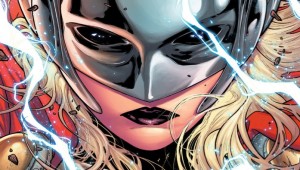Marvel’s Thor, a woman, debuts on newstands. She joins a growing list of superhuman heroines leading their own comic books — Captain Marvel, Batgirl and Catwoman, among others — as Marvel and DC push to diversify and improve the representation of women on their pages.
Part of this improvement comes through in the way these characters are dressed. Instead of a tight black bathing suit, Captain Marvel now wears a red, blue and yellow jumpsuit that evokes her Air Force roots. Over in Gotham, Batgirl has ditched the tight spandex and bright yellow heels for a leather motorcycle jacket, a detachable cape and Doc Martens.
Genevieve Valentine, lead writer on Catwoman, says having a Catwoman who wears heels in her daily life but not when she’s fighting “seems like a small thing, but of course, it’s not. It’s sort of an institutional recognition of an audience that’s always been there.”
Jeanine Schaefer, Marvel’s senior manager for talent acquisition, says they are “aware that we don’t have as many women working for us as we have men.” The issue of diversity is one that Marvel executives are seriously considering, but the change is going to take some time, she adds. “Mentoring women when they come in the door, making sure we’re placing them where they can flourish.”
Before they can hire these women, editors and talent scouts like Schaefer have to find them. And that’s where Janelle Asselin comes in. “A lot of the female creators that are up and coming are unknown quantities,” she says. “It can be hard to know how they will work on a monthly schedule. But editors need to take more risks and give more female creators a chance.”
To make it easier, Asselin started Hire This Woman. In it, she highlights female comics professionals and includes a brief interview about how fast they work, their ideal professional environments — information editors might need or want to know when hiring someone.
Her feature, and the others like it, are all part of a broader conversation happening all over the internet, on platforms like Twitter and Tumblr.
“There’s a growing and outspoken contingent of female fans that are fed up with being treated as not important,” Asselin says.
The harassment doesn’t always stay on the Internet. Asselin’s bank accounts were compromised after her article was published online, and independent comics editor Caitlin Rosberg says, “some people have had stuff mailed to their homes as a threat of ‘I know where you live.’ ”
Marvel’s Jeanine Schaefer believes this behavior is partly driven by extreme fear on the part of some comics fans.
“There’s this perception that, ‘Well, if we let women in, then everything is going to change. They’re going to take away everything that I like about comics,'” Schaefer says.
And Schaefer hopes that bringing more women and diverse voices into the creative process will prove to those fans that their favorite stories will only be enhanced by the different perspectives.
Asselin says the level of vitriol some fans aim at women working in or commenting on the comics industry is “not an OK way to treat people,” no matter the reason, but she thinks it can and will get better. These fans just need to accept that women aren’t going to leave the comics world.
After all, a genre where the unlikeliest of misfits can be heroes should have the best variety of voices to tell those stories.

